In the 1990s, the Bristol neighbourhood of Stokes Croft was a hub of unchecked creativity. The vast Victorian façades, many of which had been abandoned to the elements, were a ready-made canvas for street artists such as Banksy and Robert Del Naja (also known as 3D), who became household names. Sound systems piled into squats while the police turned a blind eye, fostering global stars such as Tricky and Massive Attack.
Two decades on, and Stokes Croft is increasingly home to artisan coffee shops, burger bars and craft ale pubs that signify urban modernity. The graffiti, once a marker of lawlessness, is now consigned to council-sanctioned tourist sites.
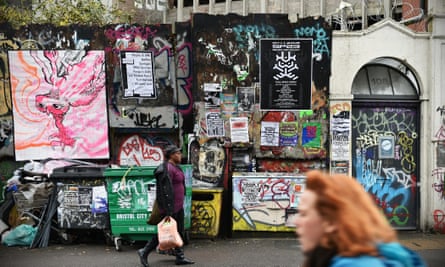
In this environment, the 123 Space, located halfway up the road of Stokes Croft, fits right in. It’s a creative venue for hire, hosting everything from art shows to coffee roastings. Its slate-grey exterior sits comfortably beside the multicoloured patchwork of high-street shopfronts. Inside, under the exposed timber and brickwork, is the Elemental Collective, a community grocery. There are no stained-glass windows and no tabernacle. Nothing marks it out as a church.
But every Thursday evening, its proprietors meet here to worship, where they stand in a circle and smile knowingly at one another: more yoga session than sermon. This is the LoveBristol church. Its members pursue idiosyncratic beliefs within a loose structure – a belief in prophecy, speaking in tongues, and the power of the Holy Spirit in instigating modern-day miracles.
They also believe in urban regeneration. The church runs a range of startups and social enterprises in the neighbourhood, including a second-hand furniture shop and a vintage clothes store. These enterprises, which generate funds for charities and community arts projects, channel the ethics of Bristol’s famous street art: an active, communal idealism and an earthy, back-to-nature spirituality. A prominent mural on the wall above LoveBristol HQ reads: “Think Local: Boycott Tesco.”
“Urban renewal is a lovely way to put what often people call gentrification,” says Neko Griffin, manager of LoveBristol enterprise Treasure retro clothes store. “That is completely the vision that I see at work in Stokes Croft. I would say it’s incredibly important because you want to be in a community where property and space is respected, and where businesses are thriving and where there’s opportunities for local people to be able to converge and connect. You don’t want an area to just be completely deprived and people to have no opportunities … that’s what is used to be like in this area.”
The church has even invested in the property market. The Stokes Croft ethos of collective living (in the past, many of the large abandoned buildings around here were home to squatters) survives in a rather more cosmopolitan iteration: LoveBristol has bought two community houses for members, part of a network of religious communes throughout the city.
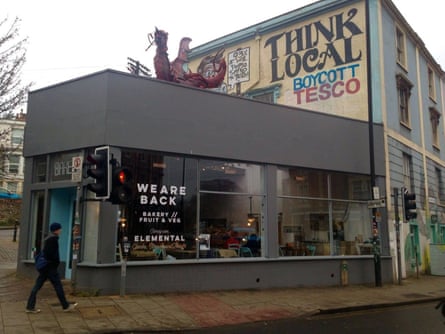
“We don’t know what the person below us is doing, the person above us, the person next door,” says Greg Thompson, founder of LoveBristol, who argues that living collectively can be a solution to an atomised society. Communal living allows for “sharing life” – and the mortgage.
Gentrification has profoundly influenced religion. It’s easy to assume that as cities grow, secularism rises. And indeed, traditional British religion is in the doldrums. According to the Brierley Consultancy, UK church membership declined from 30% of the population in 1930 to just 10.3% in 2013.
But the same report noted that evangelical, charismatic, Pentecostal and other “new churches” are going against the grain. Between 1980 and 2015, their combined attendance figures rose from 296,100 to 464,000. As every other major denomination – Anglican, Catholic, Presbyterian – rapidly shrunk, these congregations almost doubled in size.
Such pockets of Christianity are primarily persevering and growing in urban centres. In Bristol, the proliferation of local micro-breweries, vinyl revival record stores and pop-up greengrocers is mirrored in the rise of a new breed of grassroots congregation, attracting younger, trendier demographics with considerable success. A kind of “spiritual gentrification” is gaining currency.
In the context of Christianity, of course, gentrification takes on a new, existential dimension. This became clear in bizarre fashion last year, after a woman in Fort Mill, South Carolina, prophesied that Bristol was about to become “the healing capital of England”. Despite never having heard of Bristol, let alone visited it, she proclaimed that an “outpouring of healing is coming to that region ... Seeds planted years ago have come to full maturity… Winds of change are blowing and a changing of the guard is coming.”
The prophecy was persuasive enough to convince a group of evangelicals in Bristol that they were the epicentre of a grand, godly plan. To capitalise on the historic moment, they swiftly organised an international healing conference.
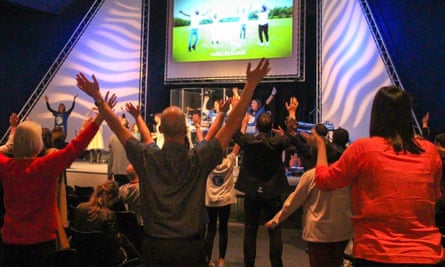
More than 600 people attended Release 2016, which was headlined by the controversial American preacher Randy Clark. Clark claims responsibility for thousands of miracles, including the blind regaining sight, the paralysed walking and people cured of cancer and Aids. As well as the faith healing, Release 2016 revelled, according to its website, in the “growing sense of unity and faith for God to move not just within the church, but also in the business sectors, social justice and the arts”.
Since the conference, the churches that brought Clark to Bristol have done their best to live up to the prophecy by calling for wholesale urban renewal. They want Stokes Croft to become not only a gateway to the city, but “a gateway to the Kingdom”. To these churchgoers, dilapidated neighbourhoods such as the old, drug-infested Stokes Croft are the fallen world – and their salvation lies not just in prayer and devotion, but in start-ups, vintage clothes stores and bakeries. One of their first acts after the conference was to revamp the Elemental grocery.
The same clientele is recognisable at Woodlands, an umbrella church under which LoveBristol operates, half a mile up the road from the 123 Space. It is run by Dave Mitchell, who attributes its appeal (Woodlands claims a 1,800-strong community) to “a social activism and desire to make the world a better place that resonates with young adults”. Throughout the week, attendees – many of whom hold degrees from the university just around the corner – filter in and out of the glass-fronted foyer. This is a world where ‘Sunday best’ means jeans and a jazzy shirt; where hymns have been displaced by contemporary American Christian rock music such as MercyMe and Natalie Grant. It’s a world of the Alpha course, varnished wood panelling, beaming faces and two-week beards, miles away from the damp austerity of traditional British Christianity.

Britain’s fastest growing congregation, however, is Pentecostalism, which has a foothold in Stokes Croft called E5 (the E stands for Elim, one of the country’s biggest Pentecostal groupings). Their focus on supernatural faith – on healing and speaking in tongues – is shared with LoveBristol, but E5 put less emphasis on woolly jumpers and green politics and more on slick online videos and social media. While local CofE and Baptist ministries have perished, E5 has adapted to the growing diversity of Bristol, with a roughly 500-strong congregation including members from more than 50 countries.
Going by the activities it offers in the neighbourhood, you could easily mistake E5 for a local leisure centre: there are youth groups, ‘Elim Tots’ gatherings for mothers and babies, and last year an Easter Sunday gig by Philippa Hanna, a “born again” singer-songwriter. They are openly pursuing their social community – modern urban dwellers – in the same way the socialist-Methodist miners of Wales had their rugby teams and choirs.
“Is urban regeneration about more than the material?” Doug Anderson, the manager of HappyTat furniture store, asks rhetorically. “Absolutely … It’s about a piece of heaven on earth … where true expressions of what Jesus did or how he lived actually articulates itself into society. Does it happen to be here on Stokes Croft? Yeah.”
Indeed, it’s not surprising that the metropolitan, left-leaning milieu of Stokes Croft is a petri dish for new types of Christianity. The politically and ethically self-aware locals are obsessed with authenticity and anti-corporatism, as are charismatics and evangelicals. Evangelism thrives on localism, on the notion that if you do your bit, the universe will take care of itself. Grow your own veg; grow your own relationship with Christ. Shop local, pray local.

“They’ve taken on buildings that were struggling and created businesses that actually seem to be helping the people who need help,” says Chris Chalkley, the chairman of the People’s Republic of Stokes Croft, a secular community group resisting corporatism in the area. He is full of admiration for the local churches, LoveBristol especially, and mentions Alain de Botton’s Religion for Atheists: “There’s got to be stuff to be learned from the way that religions organise themselves.” After all, he says, “Jesus was an activist.”
But couldn’t it be argued that LoveBristol’s trendy business ventures are actually part of the problem facing locals? Stokes Croft has become a destination neighbourhood, precisely because of its slick local retailers. In fostering such a retro, fashionable aesthetic, aren’t these churches catering for the yuppies and hipsters whose arrival is sending property prices sky-rocketing?
“There is a bit of a tension,”Thompson admits. “The more people say it’s a village, the more people say it’s a great community, the more interest in things it attracts … I’m not naive to that.”
The key, he believes “is trying to make our success everybody’s success”. He points to how the church’s social enterprises are partially staffed by voluntary ex-offenders, while profits are ploughed into homeless and addiction charities and a local arts fund. Moreover, he suggests, the church’s model of community houses offers a viable solution to the rising cost of rent.
Mitchell, too, rejects the idea that projects such as his are pushing locals out. “As far as gentrification is concerned, we have a wide demographic. We have homeless people, people with mental health problems, single parents, people in recovery and unemployed or blue collar workers alongside graduates, professionals, and quite wealthy people in worship.”
Thompson also suggests regeneration is “not just about products or services. There’s something about connection. If you can actually offer a real community – we use that word so frequently, so often, but if there is something authentic about it, then it goes beyond what is the latest thing – and that’s something that’s often missing.”
Both evangelical and secular activists in Stokes Croft are united in their desire to transcend trends and build a genuinely alternative society. “We need to work out a way of bringing morality back into the way we deal with the world,” says Chalkey. “The ideas are right. But it’s one step on a longer journey.”
This article was amended on 7 March 2017. Philippa Hanna is British, not American as an earlier version said.
Follow Guardian Cities on Twitter and Facebook to join the discussion, and explore our archive here
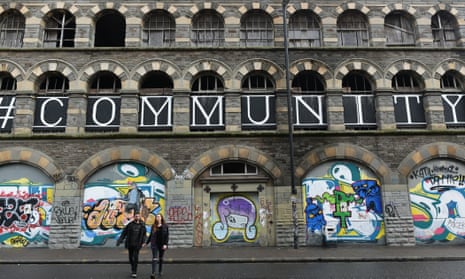




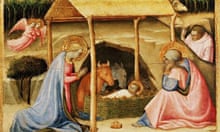

Comments (…)
Sign in or create your Guardian account to join the discussion